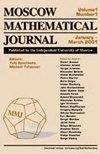椭圆曲线Gromov-Witten势的一个公式
IF 0.5
4区 数学
Q3 MATHEMATICS
引用次数: 2
摘要
Okounkov和Pandharipande在2006年获得了一种确定任何光滑投影曲线的所有Gromov-Witten不变量的算法。他们确定了具有某些Hurwitz数的平稳不变量,然后提出了Virasoro型约束,允许根据平稳不变量确定所有其他Gromov-Witten不变量。在椭圆曲线的情况下,我们证明了这些Virasoro型约束可以显式求解,从而得到了用平稳不变量表示的全Gromov-Witten势的一个非常显式的公式。本文章由计算机程序翻译,如有差异,请以英文原文为准。
A Formula For the Gromov-Witten Potential of an Elliptic Curve
An algorithm to determine all the Gromov-Witten invariants of any smooth projective curve was obtained by Okounkov and Pandharipande in 2006. They identified stationary invariants with certain Hurwitz numbers and then presented Virasoro type constraints that allow to determine all the other Gromov-Witten invariants in terms of the stationary ones. In the case of an elliptic curve, we show that these Virasoro type constraints can be explicitly solved leading to a very explicit formula for the full Gromov-Witten potential in terms of the stationary invariants.
求助全文
通过发布文献求助,成功后即可免费获取论文全文。
去求助
来源期刊
CiteScore
1.40
自引率
0.00%
发文量
16
审稿时长
>12 weeks
期刊介绍:
The Moscow Mathematical Journal (MMJ) is an international quarterly published (paper and electronic) by the Independent University of Moscow and the department of mathematics of the Higher School of Economics, and distributed by the American Mathematical Society. MMJ presents highest quality research and research-expository papers in mathematics from all over the world. Its purpose is to bring together different branches of our science and to achieve the broadest possible outlook on mathematics, characteristic of the Moscow mathematical school in general and of the Independent University of Moscow in particular.
An important specific trait of the journal is that it especially encourages research-expository papers, which must contain new important results and include detailed introductions, placing the achievements in the context of other studies and explaining the motivation behind the research. The aim is to make the articles — at least the formulation of the main results and their significance — understandable to a wide mathematical audience rather than to a narrow class of specialists.

 求助内容:
求助内容: 应助结果提醒方式:
应助结果提醒方式:


